"Early signed example of the work of Koike Naomasa. The kiku shape iron plate is well finished. The flush inlay is brass, for the scroll work on both sides, with the leaves and kiri mon in brass, copper and silver with strong detail carving. Some of the inlay goes almost over the edge, which is goishi gata. The large hitsuana are plugged in lead with starburst kokuin surface design. [...]The face is signed in deep bold kanji: Koike Naomasa; the back is signed: Izumi no Kami, on the right and Yoshiro on the left. There are one or two small pieces of inlay missing. Sold by Sotheby London, Oct. 27, 1981, lot 368. Height = 86 mm, thickness (seppa-dai) = 3.75 mm, (edge) = 4 mm."Another similar example presented at: "Tsuba" by Günter Heckmann, 1995, №T55 — "Designation: Koike Naomasa. Mid Edo, end of the 17th century. Iron, hira-zogan in brass, copper, silver and shakudo, katakiri-bori. Tendrils and leaves. 87.0 x 78.0 x 4.0 mm." Reference: Japanische Schwertzierate by Lumir Jisl, 1967, page. 13. [SV: Actually, his tsuba is signed Izumi no Kami Yoshiro on the back; and Koike Naomasa on the front, exactly as Robert Haynes's tsuba. Dating this tsuba Mid-Edo, 17th century may be considered a misattribution]. More details regarding the Yoshirō tsuba.
-
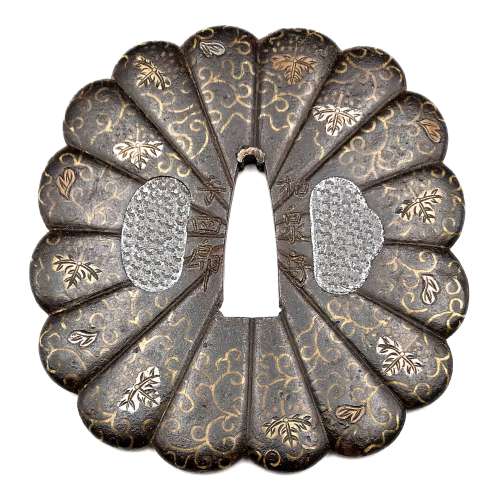 The chrysanthemoid (kiku-gata) iron plate with polished surface decorated with arabesque (karakusa) and paulownia (kiri) leaves and flowers in brass, copper and silver flush inlay (hira-zōgan) on both sides. Some of the inlay goes over the edge. Kozuka- and kogai-hitsu-ana are filled with lead plugs. Sekigane of copper. Chrysanthemum and paulownia are the symbols of imperial family. The face is signed: Izumi no Kami to the right of nakago-ana, and Yoshiro on the left; the back is signed Koike Naomasa. His signed work is considered by many experts to have been made-to-order only. The original wooden box (tomobako) with inscription (hakogaki) signed by Dr. Kazutaro Torigoye and dated Showa 39 (1964). The late Muromachi or Momoyama period, 16th century. Dimensions: 89 mm x 84 mm x 3.6 mm; Weight: 170 g. Hakogaki lid: Yoshirō kikka-gata Hakogaki lid inside: Iron, signed on the omote: Izumi no Kami – Yoshirō; on the ura: Koike Naomasa. Kikka-gata, pronounced maru-mumi, two hitsu-ana, karakusa, and kiri design in brass, silver, and suaka hira-zōgan. Height 8.5 cm, thickness 3.5 mm. Herewith I judge this work as authentic. On a lucky day in July of 1964. Torigoe Kōdō [Kazutarō] + kaō According to Robert Haynes [Catalog #7, 1983; №32, page 42-43] "This full form of the signature is seen very rarely". His example, illustrated in that catalogue, measures: height = 86 mm, thickness at seppa-dai = 3.75 mm and signed Izumi no Kami Yoshiro on the back and Koike Naomasa on the face. The further description of his specimen by Robert Haynes:
The chrysanthemoid (kiku-gata) iron plate with polished surface decorated with arabesque (karakusa) and paulownia (kiri) leaves and flowers in brass, copper and silver flush inlay (hira-zōgan) on both sides. Some of the inlay goes over the edge. Kozuka- and kogai-hitsu-ana are filled with lead plugs. Sekigane of copper. Chrysanthemum and paulownia are the symbols of imperial family. The face is signed: Izumi no Kami to the right of nakago-ana, and Yoshiro on the left; the back is signed Koike Naomasa. His signed work is considered by many experts to have been made-to-order only. The original wooden box (tomobako) with inscription (hakogaki) signed by Dr. Kazutaro Torigoye and dated Showa 39 (1964). The late Muromachi or Momoyama period, 16th century. Dimensions: 89 mm x 84 mm x 3.6 mm; Weight: 170 g. Hakogaki lid: Yoshirō kikka-gata Hakogaki lid inside: Iron, signed on the omote: Izumi no Kami – Yoshirō; on the ura: Koike Naomasa. Kikka-gata, pronounced maru-mumi, two hitsu-ana, karakusa, and kiri design in brass, silver, and suaka hira-zōgan. Height 8.5 cm, thickness 3.5 mm. Herewith I judge this work as authentic. On a lucky day in July of 1964. Torigoe Kōdō [Kazutarō] + kaō According to Robert Haynes [Catalog #7, 1983; №32, page 42-43] "This full form of the signature is seen very rarely". His example, illustrated in that catalogue, measures: height = 86 mm, thickness at seppa-dai = 3.75 mm and signed Izumi no Kami Yoshiro on the back and Koike Naomasa on the face. The further description of his specimen by Robert Haynes: -
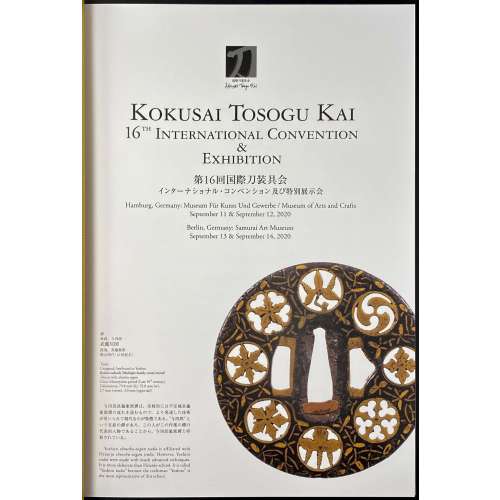 An annual publication of Kokusai Tosogu Kai / 16th International Convention & Exhibition in Hamburg, Germany: Museum Für Kunst Und Gewerbe / Museum of Arts and Crafts, September 11-12, 2020 and Berlin, Germany: Samurai Art Museum, September 13-14, 2020. Publisher: Tokyo: Kokusai Tosogu Kai, 2020. Pagination: [1-3] 4-103 [1]. Size: Medium 4to (30.3 x 21.6 cm), hardcover, original illustrated paper boards, in a slipcase. Tsuba from this collection depicted on the title page and pp. 59-60: TSU-0342.2017, TSU 0376.2018, and TSU 0379.2018. See also here.
An annual publication of Kokusai Tosogu Kai / 16th International Convention & Exhibition in Hamburg, Germany: Museum Für Kunst Und Gewerbe / Museum of Arts and Crafts, September 11-12, 2020 and Berlin, Germany: Samurai Art Museum, September 13-14, 2020. Publisher: Tokyo: Kokusai Tosogu Kai, 2020. Pagination: [1-3] 4-103 [1]. Size: Medium 4to (30.3 x 21.6 cm), hardcover, original illustrated paper boards, in a slipcase. Tsuba from this collection depicted on the title page and pp. 59-60: TSU-0342.2017, TSU 0376.2018, and TSU 0379.2018. See also here. -
 Description: One volume, 8vo, 22 x 14.5 cm, in brown paper boards with orange and black lettering to spine, pictorial dust jacket, unclipped “PRICE | 30s net | IN U.K. ONLY”, collated [A]-S8, pp.: [i-vi] vii-xiii [xiv blank], 1-273 [274 blank], 144 leaves total. Edition: 1st English edition. Original title: Das Sogenannte Böse: zur Naturgeschichte der Aggression. — Wien : Dr. G. Borotha-Schoeler, 1963. Contributors: Konrad Zacharias Lorenz (Austrian, 1903 – 1989) – author. Sir Julian Sorell Huxley (British, 1887 – 1975) – author of the foreword. Marjorie Latzke [Kerr Wilson] (American, 20th century) – translator from German. Methuen & Co Ltd. (London) – publisher. Cox & Wyman Ltd. (Fakenham, Norfolk) – printer.
Description: One volume, 8vo, 22 x 14.5 cm, in brown paper boards with orange and black lettering to spine, pictorial dust jacket, unclipped “PRICE | 30s net | IN U.K. ONLY”, collated [A]-S8, pp.: [i-vi] vii-xiii [xiv blank], 1-273 [274 blank], 144 leaves total. Edition: 1st English edition. Original title: Das Sogenannte Böse: zur Naturgeschichte der Aggression. — Wien : Dr. G. Borotha-Schoeler, 1963. Contributors: Konrad Zacharias Lorenz (Austrian, 1903 – 1989) – author. Sir Julian Sorell Huxley (British, 1887 – 1975) – author of the foreword. Marjorie Latzke [Kerr Wilson] (American, 20th century) – translator from German. Methuen & Co Ltd. (London) – publisher. Cox & Wyman Ltd. (Fakenham, Norfolk) – printer. -
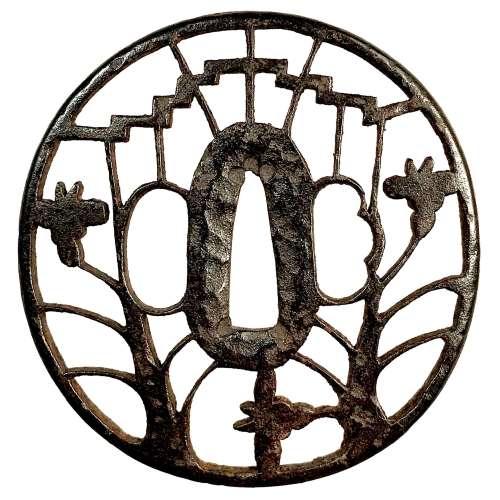
Kyo school iron tsuba of round form decorated with an eight-plank bridge (yatsuhashi) and irises (kakitsubata) in openwork (sukashi).
Late Muromachi period, Tenbun era (early 16th centiry).Dimensions: 80.0 x 77.2 x 4.1 mm.
The design alludes to the scene in 'Ise Monogatari', where Ariwara no Narihira being exiled from Kyoto to the Kanto region crossed the eight-plank bridge at Mikawa looking at the irises in bloom and composed a poem expressing his desire to return to Kyoto. A lot of tsuba have been produced with the similar design.
Reference: Masterpieces from the Sasano collection, 1994, p. 98, №69. -
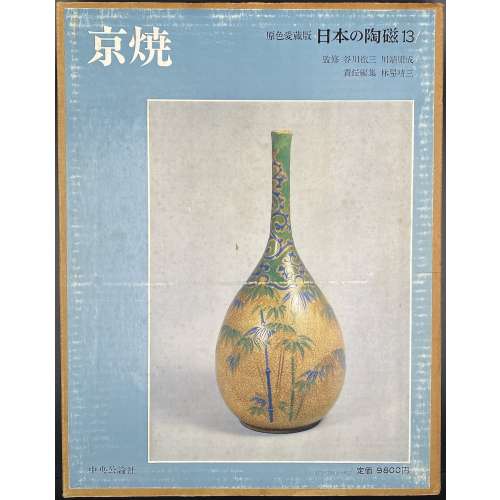 Hardcover volume, 35 x 27 cm, bound in grey cloth, blind stamped characters to front, brown characters to spine, in a glassine dust jacket, in a double slipcase, the outer case pictorial paper over cardboard, 36 x 28 cm, pp.: [4] [1] 2-124 (plates with photographs of 241 items), [2] 127-171 [3]. Kyō ware [京焼] (Kyō-yaki) – pottery from Kyoto. 日本の陶磁 – Japanese ceramics, series title. Contributors: Yasunari Kawabata [川端 康成] (Japanese, 1924 – 1972) – author. Tetsuzo Tanikawa [谷川 徹三] (Japanese, 1895 – 1989) – author. Seizo Hayashiya [林屋晴三] (Japanese, 1928 – 2017) – editor. Chūōkōron-sha [中央公論社] – publisher.
Hardcover volume, 35 x 27 cm, bound in grey cloth, blind stamped characters to front, brown characters to spine, in a glassine dust jacket, in a double slipcase, the outer case pictorial paper over cardboard, 36 x 28 cm, pp.: [4] [1] 2-124 (plates with photographs of 241 items), [2] 127-171 [3]. Kyō ware [京焼] (Kyō-yaki) – pottery from Kyoto. 日本の陶磁 – Japanese ceramics, series title. Contributors: Yasunari Kawabata [川端 康成] (Japanese, 1924 – 1972) – author. Tetsuzo Tanikawa [谷川 徹三] (Japanese, 1895 – 1989) – author. Seizo Hayashiya [林屋晴三] (Japanese, 1928 – 2017) – editor. Chūōkōron-sha [中央公論社] – publisher. -
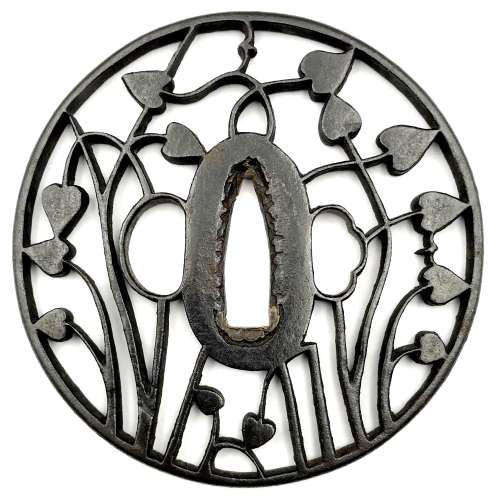 Kyo-sukashi iron tsuba of round form with design of hollyhock (aoi ) and wild geese. Slightly rounded rim. Copper sekigane. Momoyama period, late 16th - early 17th century. Height: 82.6 mm, Width: 82.1 mm, Thickness at seppa-dai: 4.5 mm. NTHK (Nihon Token Hozon Kai) certified.
Kyo-sukashi iron tsuba of round form with design of hollyhock (aoi ) and wild geese. Slightly rounded rim. Copper sekigane. Momoyama period, late 16th - early 17th century. Height: 82.6 mm, Width: 82.1 mm, Thickness at seppa-dai: 4.5 mm. NTHK (Nihon Token Hozon Kai) certified. -
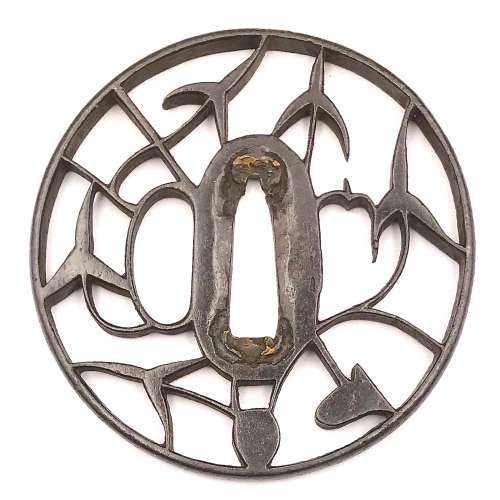 Iron tsuba of round form with design of water plantain (omodaka) and wild goose in openwork (sukashi). Slightly rounded, square rim. Copper sekigane. Kyo school. Late Muromachi period: Early 16th century (Tenbun era) [Sasano's attribution]. Height: 76.2 mm. Width: 75.8 mm. Rim thickness: 5.3 mm. Center thickness: 4.5 mm. Provenance: Sasano Masayuki Collection, № 68: "The water plantain (omodaka) first appeared as a design for sword fittings in the Heian period. From such early beginnings, this decorative plant has shared a long history with the samurai. Also known as shogun's grass (shogununso), it was held in high esteem as a symbol of victory". The same tsuba was found at Japanese Swords and Tsuba from the Professor A. Z. Freeman and the Phyllis Sharpe Memorial collections. Sotheby's, London, Thursday 10 April 1997, page 22, item 60, saying that this is a "Kyo-sukashi tsuba, early to middle Edo period (late 17th/18th century) [Sotheby's attribution], and that it represents "a small bird among omodaka and aoi plants".
Iron tsuba of round form with design of water plantain (omodaka) and wild goose in openwork (sukashi). Slightly rounded, square rim. Copper sekigane. Kyo school. Late Muromachi period: Early 16th century (Tenbun era) [Sasano's attribution]. Height: 76.2 mm. Width: 75.8 mm. Rim thickness: 5.3 mm. Center thickness: 4.5 mm. Provenance: Sasano Masayuki Collection, № 68: "The water plantain (omodaka) first appeared as a design for sword fittings in the Heian period. From such early beginnings, this decorative plant has shared a long history with the samurai. Also known as shogun's grass (shogununso), it was held in high esteem as a symbol of victory". The same tsuba was found at Japanese Swords and Tsuba from the Professor A. Z. Freeman and the Phyllis Sharpe Memorial collections. Sotheby's, London, Thursday 10 April 1997, page 22, item 60, saying that this is a "Kyo-sukashi tsuba, early to middle Edo period (late 17th/18th century) [Sotheby's attribution], and that it represents "a small bird among omodaka and aoi plants". -
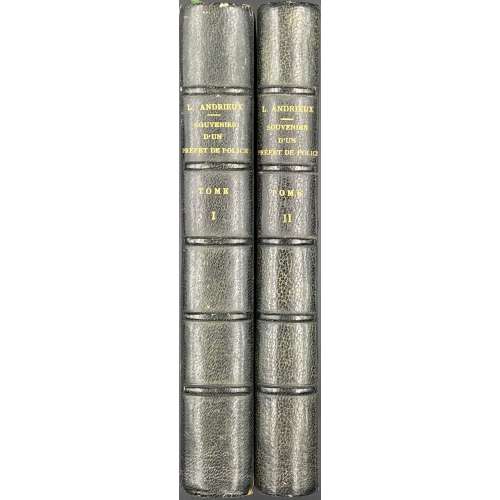 Vol. 1. Title: SOUVENIRS | D'UN | PRÉFET DE POLICE | PAR | L. ANDRIEUX | TOME PREMIER | {publisher’s device} | PARIS | JULES ROUFF ET Cie, ÉDITEURS | 14, CLOITRE SAINT-HONORÉ, 14 | 1885 || Pagination : [1-7] 8-356. Collation: 18mo; 1-1718 1916. Vol. 2. Title: Similar but TOME DEUXIÈME. Pagination : [1-5] 6-304. Collation: 18mo; 1-1518 176. Binding: Both volumes are uniformly bound in quarter black morocco over marbled boards, raised bands, gilt lettering, peacock endpapers, all edges marbled; extensive foxing.
Vol. 1. Title: SOUVENIRS | D'UN | PRÉFET DE POLICE | PAR | L. ANDRIEUX | TOME PREMIER | {publisher’s device} | PARIS | JULES ROUFF ET Cie, ÉDITEURS | 14, CLOITRE SAINT-HONORÉ, 14 | 1885 || Pagination : [1-7] 8-356. Collation: 18mo; 1-1718 1916. Vol. 2. Title: Similar but TOME DEUXIÈME. Pagination : [1-5] 6-304. Collation: 18mo; 1-1518 176. Binding: Both volumes are uniformly bound in quarter black morocco over marbled boards, raised bands, gilt lettering, peacock endpapers, all edges marbled; extensive foxing. -
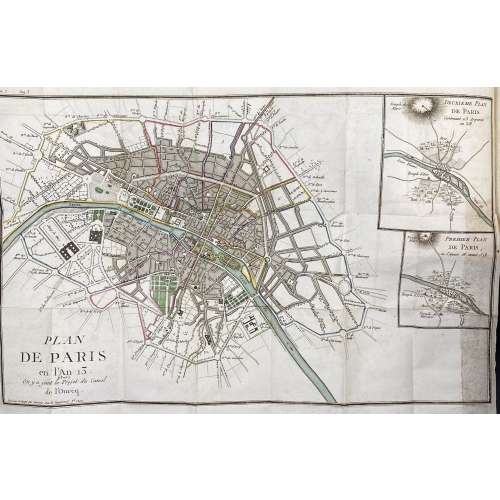 Two volumes, 12mo; 14 x 9 cm, uniformly bound in speckled calf with dentelle border in gilt, gilt-stamped spine with two crimson lettered labels, marbled endpapers. Inscription to h.t.: P. Leigh Smith | Moscow | 1921 || Vol. 1: Half-title: MIROIR | DE L'ANCIEN ET DU NOUVEAU | PARIS, | AVEC TREIZE VOYAGES | EN VÉLOCIFÈRES, |DANS SES ENVIRONS. | TOME I. || Title page: MIROIR | DE L'ANCIEN ET DU NOUVEAU | PARIS, | AVEC TREIZE VOYAGES | EN VÉLOCIFÈRES, |DANS SES ENVIRONS. Ouvrage indespensable aus Étrangers et même | aux Parisiens, et qui indique tout ce qu’il faut | connoître et éviter dans cette capitale. | Orné d’un Plan de Paris et de 18 Gravures | {to the right, in single rules} Tels temps, telles mœurs. | Par L. Prudhomme. | Tome I. | PARIS, | PRUDHOMME, fils, rue des Marais, F. B. St.-G. | DEBRAY, rue St. Honoré, barrière des Sergens. | AN XIII. — (1804.) || Pagination: [i-vii] viii-xxxvi, 1-260; total 296 pages + 15 copperplate engravings and 1 folding plan of Paris. Collation: πA-πC6, A-C6, 4-216 224; total 148 leaves + 15 plates + 1 folding. Note: 12mo; πA1 unsigned, A2 unsigned, A–C3 signed A-C5, respectively, 4* unsigned, 9* marked 8*, 18* marked 17*. Vol. 2: Similar half-title and title, TOME II instead of TOME I. Pagination: [4] 1-408; total 412 pages + 3 copperplate engravings. Collation: π2, 1-346; total 206 leaves + 3 plates.
Two volumes, 12mo; 14 x 9 cm, uniformly bound in speckled calf with dentelle border in gilt, gilt-stamped spine with two crimson lettered labels, marbled endpapers. Inscription to h.t.: P. Leigh Smith | Moscow | 1921 || Vol. 1: Half-title: MIROIR | DE L'ANCIEN ET DU NOUVEAU | PARIS, | AVEC TREIZE VOYAGES | EN VÉLOCIFÈRES, |DANS SES ENVIRONS. | TOME I. || Title page: MIROIR | DE L'ANCIEN ET DU NOUVEAU | PARIS, | AVEC TREIZE VOYAGES | EN VÉLOCIFÈRES, |DANS SES ENVIRONS. Ouvrage indespensable aus Étrangers et même | aux Parisiens, et qui indique tout ce qu’il faut | connoître et éviter dans cette capitale. | Orné d’un Plan de Paris et de 18 Gravures | {to the right, in single rules} Tels temps, telles mœurs. | Par L. Prudhomme. | Tome I. | PARIS, | PRUDHOMME, fils, rue des Marais, F. B. St.-G. | DEBRAY, rue St. Honoré, barrière des Sergens. | AN XIII. — (1804.) || Pagination: [i-vii] viii-xxxvi, 1-260; total 296 pages + 15 copperplate engravings and 1 folding plan of Paris. Collation: πA-πC6, A-C6, 4-216 224; total 148 leaves + 15 plates + 1 folding. Note: 12mo; πA1 unsigned, A2 unsigned, A–C3 signed A-C5, respectively, 4* unsigned, 9* marked 8*, 18* marked 17*. Vol. 2: Similar half-title and title, TOME II instead of TOME I. Pagination: [4] 1-408; total 412 pages + 3 copperplate engravings. Collation: π2, 1-346; total 206 leaves + 3 plates. -
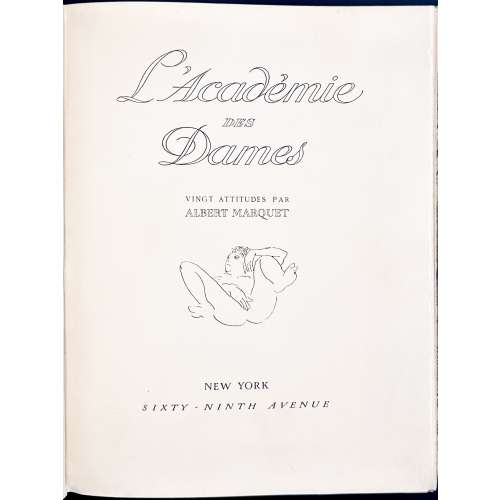 NEWHardcover, 330 x 255 mm, marble paper, two labels of black calf with gilt lettering to spine, 2 blank leaves at front and 2 at back (laid paper), two leaves of lithographic vignettes (t.p. and limitation), plus 20 lithographic plates signed “am”, unpaginated. Limited edition of 25 copies on Japon Impérial paper №№ 1-25, 300 copies on Vélin d’Arches №№ 26-325, of which this is copy № 206. Stones sanded. A poem by Verlaine at p. 2 recto. Title-page: L'Académie | DES | Dames | VINGT ATTITUDES PAR | ALBERT MARQUET | {vignette} | NEW YORK | SIXTY-NINTH AVENUE || Imprint: ÉDITION PRIVÉE | EXEMPLAIRE NUMERO 206 Limitation: JUSTIFICATION DU TIRAGE | IL A ÉTÉ TIRÉ DE CET OUVRAGE | VINGT-CINQ EXEMPLAIRES SUR JAPON IMPÉRIAL | NUMÉROTÉS DE 1 à 25 | ET TROIS CENTS EXEMPLAIRES SUR VÉLIN D'ARCHES | NUMÉROTÉS DE 26 à 325 | PIERRES BIFFÉES || Catalogue raisonné: Dutel III № 949; Nordmann I № 255. Provenance: From the collection of Hans-Jürgen Döpp, Frankfurt. Contributors: Albert Marquet (French, 1875 – 1947) Verlaine, Paul (French, 1844 – 1896) One additional lithographic plate by Marquet from a different source but on a similar subject is laid in.
NEWHardcover, 330 x 255 mm, marble paper, two labels of black calf with gilt lettering to spine, 2 blank leaves at front and 2 at back (laid paper), two leaves of lithographic vignettes (t.p. and limitation), plus 20 lithographic plates signed “am”, unpaginated. Limited edition of 25 copies on Japon Impérial paper №№ 1-25, 300 copies on Vélin d’Arches №№ 26-325, of which this is copy № 206. Stones sanded. A poem by Verlaine at p. 2 recto. Title-page: L'Académie | DES | Dames | VINGT ATTITUDES PAR | ALBERT MARQUET | {vignette} | NEW YORK | SIXTY-NINTH AVENUE || Imprint: ÉDITION PRIVÉE | EXEMPLAIRE NUMERO 206 Limitation: JUSTIFICATION DU TIRAGE | IL A ÉTÉ TIRÉ DE CET OUVRAGE | VINGT-CINQ EXEMPLAIRES SUR JAPON IMPÉRIAL | NUMÉROTÉS DE 1 à 25 | ET TROIS CENTS EXEMPLAIRES SUR VÉLIN D'ARCHES | NUMÉROTÉS DE 26 à 325 | PIERRES BIFFÉES || Catalogue raisonné: Dutel III № 949; Nordmann I № 255. Provenance: From the collection of Hans-Jürgen Döpp, Frankfurt. Contributors: Albert Marquet (French, 1875 – 1947) Verlaine, Paul (French, 1844 – 1896) One additional lithographic plate by Marquet from a different source but on a similar subject is laid in.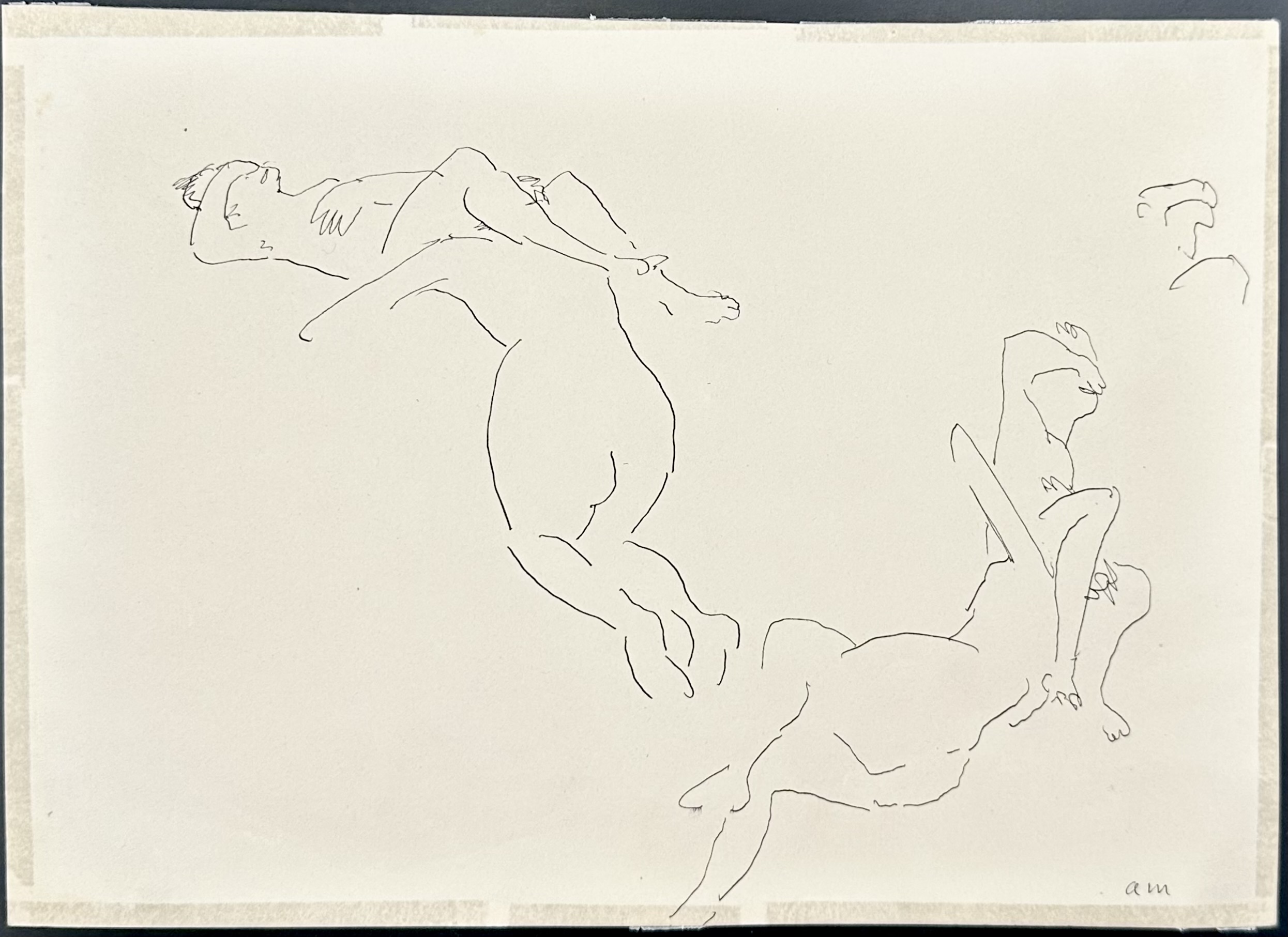
-
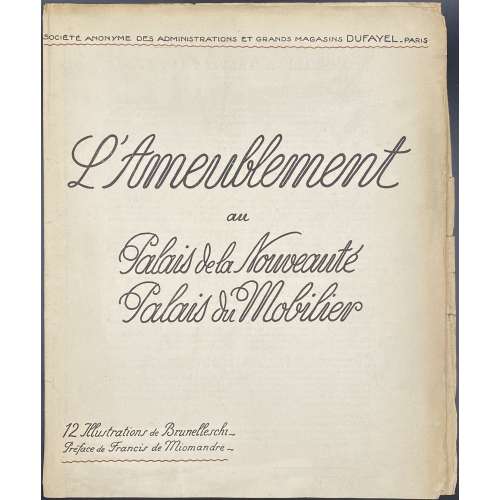 A set of 12 photomechanically reproduced illustrations after gouaches by Umberto Brunelleschi (Italian, 1879 – 1949), in colour; b/w photographs reproductions on verso, in a paper folder without the outer wrappers (b/w with birds, insects, and flowers). Text on the folder by French novelist Francis de Miomandre (French, 1880 – 1959); published by Grands Magasins Dufayel (1856 – 1930), a Parisian department store, run by Georges Dufayel (French, 1855 – 1916). Size: 29 x 24 cm. Images printed on cream paper within a beige frame, lettered above the frame in beige: "Societé Anonyme des Administrations et Grands Magasins DUFAYEL — Paris —", under the frame: "Palais de la Nouveauté ~ Palais du Mobilier | Entrée principale 7 Bould BARBES"; at the bottom of the frame lettered black on each image: Le Style Chinois, Le Style Empire, Le Style Japonais, Le Style Louis XIV, Le Style Louis XV, Le Style Louis XVI, Le Style Moderne (2), Le Style Moyen Age, Le Style Renaissance, Le Style Vénitien, Le Style Persian.
A set of 12 photomechanically reproduced illustrations after gouaches by Umberto Brunelleschi (Italian, 1879 – 1949), in colour; b/w photographs reproductions on verso, in a paper folder without the outer wrappers (b/w with birds, insects, and flowers). Text on the folder by French novelist Francis de Miomandre (French, 1880 – 1959); published by Grands Magasins Dufayel (1856 – 1930), a Parisian department store, run by Georges Dufayel (French, 1855 – 1916). Size: 29 x 24 cm. Images printed on cream paper within a beige frame, lettered above the frame in beige: "Societé Anonyme des Administrations et Grands Magasins DUFAYEL — Paris —", under the frame: "Palais de la Nouveauté ~ Palais du Mobilier | Entrée principale 7 Bould BARBES"; at the bottom of the frame lettered black on each image: Le Style Chinois, Le Style Empire, Le Style Japonais, Le Style Louis XIV, Le Style Louis XV, Le Style Louis XVI, Le Style Moderne (2), Le Style Moyen Age, Le Style Renaissance, Le Style Vénitien, Le Style Persian. -
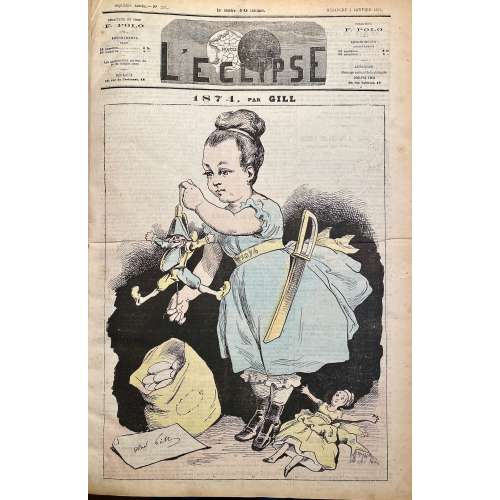 129 issues of L'Éclipse, French weekly political magazine; published in Paris, 49 x 34 cm, bound in rebacked green quarter morocco over marbled boards, with gilt fillets and lettering to spine, peacock marbled endpapers, illustrated by André Gill (French, 1840 – 1885). Founder and editor-in-chief François Polo (French, 1838 – 1874). 1874: 271-322 (52 issues) 1875: 323-374 (52 issues) 1876: 375-399 (25 issues)
129 issues of L'Éclipse, French weekly political magazine; published in Paris, 49 x 34 cm, bound in rebacked green quarter morocco over marbled boards, with gilt fillets and lettering to spine, peacock marbled endpapers, illustrated by André Gill (French, 1840 – 1885). Founder and editor-in-chief François Polo (French, 1838 – 1874). 1874: 271-322 (52 issues) 1875: 323-374 (52 issues) 1876: 375-399 (25 issues) -
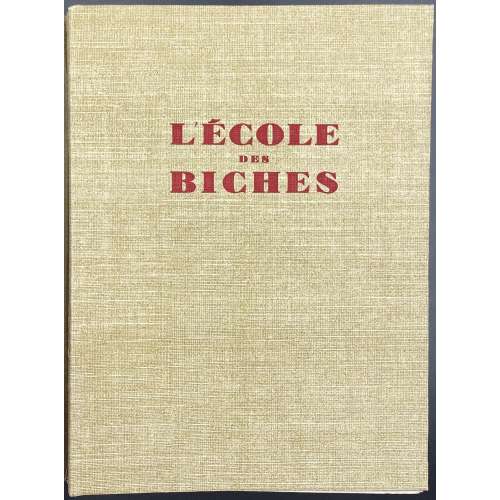 Softcover volume, 22.8 x 17 cm, French flapped wrapper simulating unprimed canvas with crimson lettering to front; pp.: ffl, [5/6] h.t., [7/8] t.p., 9-109 [110], [111/112] limitation/blank, ffl; plus 12 colour lithographs by Schem (Raoul Serres), incl. frontispiece; printed on wove paper. Title-page (red and black): L'ÉCOLE | DES | BICHES | OU | MŒURS DES | PETITES DAMES DE CE TEMPS | [blank] | M. CM. XXXIX. || Limitation: printed 99 copies of which this is № 27; date of printing July 10, 1939. Catalog raisonné: Dutel III № 1447. As per J.-P. Dutel (II № 231 pp 119-20), the text was published in Brussels in 1868 by Jean-Pierre Blanche. Presumed authors are Alfred Bégis, Frederick Hankey and Edmund Duponchel. [BEGIS, Alfred, with DUPONCHEL, Edmond, and HANKEY, Frederick, attributed to.] L'École des Biches ou Mœurs des petites dames de ce temps. Paris [but Brussels]: [Jean-Pierre Blanche,] 1863 [1868] sold at Christie’s for GBP 1,000 on November 18, 2014. For details, see [LIB-2812.2021] Highlights from the Erotica Library of Tony Fekete / Auction catalogue, Tuesday 18 November 2014. — London: Christie's, 2014. — Lot 36. Contributors: Alfred Bégis (French, 1829 – 1904) – author. Frederick Hankey (British, 1823 – 1882) – author. Edmund Duponchel (French, c. 1795 – 1868) – author. Jean-Pierre Blanche (Beligian, second half of the 19th century) – publisher. Schem [real name Raoul Serres] (French, 1881– 1971) – artist.
Softcover volume, 22.8 x 17 cm, French flapped wrapper simulating unprimed canvas with crimson lettering to front; pp.: ffl, [5/6] h.t., [7/8] t.p., 9-109 [110], [111/112] limitation/blank, ffl; plus 12 colour lithographs by Schem (Raoul Serres), incl. frontispiece; printed on wove paper. Title-page (red and black): L'ÉCOLE | DES | BICHES | OU | MŒURS DES | PETITES DAMES DE CE TEMPS | [blank] | M. CM. XXXIX. || Limitation: printed 99 copies of which this is № 27; date of printing July 10, 1939. Catalog raisonné: Dutel III № 1447. As per J.-P. Dutel (II № 231 pp 119-20), the text was published in Brussels in 1868 by Jean-Pierre Blanche. Presumed authors are Alfred Bégis, Frederick Hankey and Edmund Duponchel. [BEGIS, Alfred, with DUPONCHEL, Edmond, and HANKEY, Frederick, attributed to.] L'École des Biches ou Mœurs des petites dames de ce temps. Paris [but Brussels]: [Jean-Pierre Blanche,] 1863 [1868] sold at Christie’s for GBP 1,000 on November 18, 2014. For details, see [LIB-2812.2021] Highlights from the Erotica Library of Tony Fekete / Auction catalogue, Tuesday 18 November 2014. — London: Christie's, 2014. — Lot 36. Contributors: Alfred Bégis (French, 1829 – 1904) – author. Frederick Hankey (British, 1823 – 1882) – author. Edmund Duponchel (French, c. 1795 – 1868) – author. Jean-Pierre Blanche (Beligian, second half of the 19th century) – publisher. Schem [real name Raoul Serres] (French, 1881– 1971) – artist. -
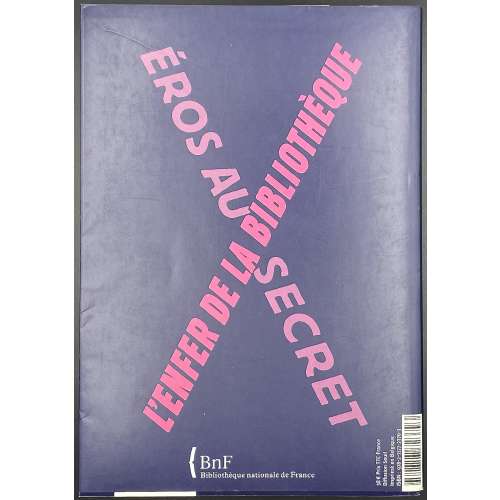 Exhibition held December 4, 2007, to March 2, 2008, at the Bibliothèque Nationale de France. Title: L'enfer de la Bibliothèque | ÉROS AU SECRET | Sous la direction | de Marie-Françoise Quignard | et Raymond-Josué Seckel | [spase] | {BnF | Bibliothèque nationale de France || Description: 23 x 16 cm, publisher’s lettered wrappers and pictorial dust jacket, [1-17] 18-460 [4], ils.; 257 entries, 8 pp. bibliography, 10 pp. index.
Exhibition held December 4, 2007, to March 2, 2008, at the Bibliothèque Nationale de France. Title: L'enfer de la Bibliothèque | ÉROS AU SECRET | Sous la direction | de Marie-Françoise Quignard | et Raymond-Josué Seckel | [spase] | {BnF | Bibliothèque nationale de France || Description: 23 x 16 cm, publisher’s lettered wrappers and pictorial dust jacket, [1-17] 18-460 [4], ils.; 257 entries, 8 pp. bibliography, 10 pp. index. -
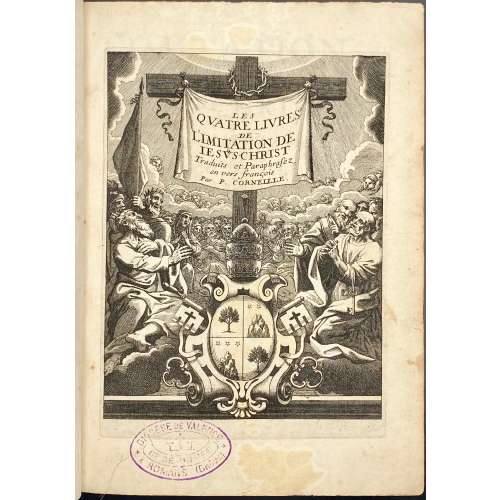 L'Imitation de Jésus-Christ / Traduite et paraphrasée en Vers François Par P. Corneille. — A Paris, Chez Pierre Rocolet, Imprimeur & Libraire ordinaire du Roy, au Palais, en la Gallerie des Prisonniers, aux Armes du Roy & de la Ville. M. DC. LVI. Avec Approbation des Docteurs, et Privelege de sa Majesté. Paris: Pierre Rocolet, 1656. Half-title: Les Quatre Livres de L'Imitation de Iesus-Christ. Traduites et paraphrasez en vers françois Par P. Corneille. — pp.: ff [2 pictorial ht, verso blank] [2 title, blank] [10 epistre] [2 av lecteur] [2 approbation, frontis.] 1-551 [552-60 table, privilege] bf. 8vo, 24.7 x 18.7 cm, hardcover; full speckled brown calf, gilt double-ruled boards, spine with raised bands, gilt double-ruled compartments with lozenges, sprayed margins; pages darkened. Purple ink stamp of Diocèse de Valencia to half-title. Nut ink ex libris handwriting on front paste-down. Plates: Half-title: unsigned copper engraving with the coat of arms of Pope Alexander VII (r. 1655 – 1667) which contains an oak tree in the top left and bottom right quarters (from Della Rovere family, Dukes of Urbino), the top right and bottom left quarters feature a mountain of six coupeaux in base with three stars above (from Chigi family). Four copper engravings inbound at the beginning of each book signed 'F. Chauueau in et fe.': Page 1: Jesus teaches His disciple. Page 113: Annunciation. Page 183: Jesus meets Simon called Peter and his brother Andrew. Page 459: Last Supper. François Chauveau (10 May 1613, Paris – 3 February 1676, Paris), a French painter and engraver. Thomas à Kempis (c. 1380 – 25 July 1471), a German-Dutch canon regular. Pierre Corneille (1606 – 1684), a French poet and playwright. Pierre Rocolet (1610 – 1662, active circa 1638 à 1662), a French publisher and printer.
L'Imitation de Jésus-Christ / Traduite et paraphrasée en Vers François Par P. Corneille. — A Paris, Chez Pierre Rocolet, Imprimeur & Libraire ordinaire du Roy, au Palais, en la Gallerie des Prisonniers, aux Armes du Roy & de la Ville. M. DC. LVI. Avec Approbation des Docteurs, et Privelege de sa Majesté. Paris: Pierre Rocolet, 1656. Half-title: Les Quatre Livres de L'Imitation de Iesus-Christ. Traduites et paraphrasez en vers françois Par P. Corneille. — pp.: ff [2 pictorial ht, verso blank] [2 title, blank] [10 epistre] [2 av lecteur] [2 approbation, frontis.] 1-551 [552-60 table, privilege] bf. 8vo, 24.7 x 18.7 cm, hardcover; full speckled brown calf, gilt double-ruled boards, spine with raised bands, gilt double-ruled compartments with lozenges, sprayed margins; pages darkened. Purple ink stamp of Diocèse de Valencia to half-title. Nut ink ex libris handwriting on front paste-down. Plates: Half-title: unsigned copper engraving with the coat of arms of Pope Alexander VII (r. 1655 – 1667) which contains an oak tree in the top left and bottom right quarters (from Della Rovere family, Dukes of Urbino), the top right and bottom left quarters feature a mountain of six coupeaux in base with three stars above (from Chigi family). Four copper engravings inbound at the beginning of each book signed 'F. Chauueau in et fe.': Page 1: Jesus teaches His disciple. Page 113: Annunciation. Page 183: Jesus meets Simon called Peter and his brother Andrew. Page 459: Last Supper. François Chauveau (10 May 1613, Paris – 3 February 1676, Paris), a French painter and engraver. Thomas à Kempis (c. 1380 – 25 July 1471), a German-Dutch canon regular. Pierre Corneille (1606 – 1684), a French poet and playwright. Pierre Rocolet (1610 – 1662, active circa 1638 à 1662), a French publisher and printer. -
 L'incendie de Hôtel de Ville (24 mai 1871). A woodcut by Provost; printed by Imp. Charaire et fils; F. Roy, éditier.
L'incendie de Hôtel de Ville (24 mai 1871). A woodcut by Provost; printed by Imp. Charaire et fils; F. Roy, éditier. -
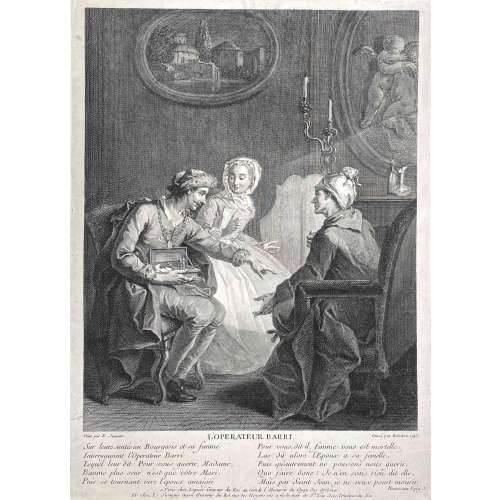
Engraving by J.J. Balechou after E. Jeaurat. A husband and wife ask a quack doctor for advice about health: he suggests substituting himself for the husband in the wife's affections, and she agrees: Épigrammes de Jean-Baptiste Rousseau (French, 1671–1741).
Date: 1743.
Size: 380 x 270 mm
Inscriptions under the image:
Top: Peint par E. Jeaurat | L'Operateur Barri | Grave par Balechou 1743
Middle: Sur leurs santés un Bourgeois et sa femme
Interrogeoient l'Operateur Barri, Lequel leur dit : Pour vous guérir, Madame, Baume plus sûr n'est que votre Mari, Puis se tournant vers l'époux amaigri, Pour vous, dit il, femme vous est mortelle, Las ! dit alors l'Epoux à sa femelle, Puis qu'autrement ne pouvons nous guérir, Que faire donc ? Je n'en sçai rien, dit elle,Mais, par Saint Jean, je ne veux point mourir.
Rousseau Epig. X
Center bottom: a Paris chez Lepicie Graveur du Roi au coin de l'Abreuvoir du Quay des Orfevres. Et Chez L. Surugue Aussi Graveur du Roi rue des Noyers vis a vis le mur de St. Yves Avec Privilege du Roi. -
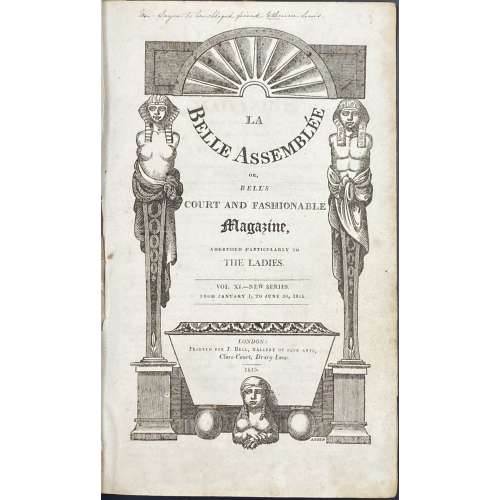 Title: LA | BELLE ASSEMBLÉE | OR, | BELL'S | COURT AND FASHIONABLE | MAGAZINE, | ADDRESSED PARTICULARLY TO | THE LADIES. | VOL. XI.—NEW SERIES. | FROM JANUARY 1, TO JUNE 30, 1815. | LONDON: | Printed for J. BELL, GALLERY OF FINE ARTS, | Clare-Court, Drury-Lane. | 1815. || Pagination: [2] – 11th volume wood-engraved pictorial title page, [1, 2] – January faux-title and table of content, [3] 4-284 [2] – index to 11th vol. Notes: February f.t. not paginated, but within the collation; the last page of the index at the very end paginated [iii]/iv, so pages i/ii missing (the gathering Nn lacking one sheet) Collation: 4to; π1 A-Mm4 Nn3, 28 plates extraneous to collation (lacking 2 plates). Binding: Half brown morocco over marbled boards, flat spine, compartments gilt-ruled with double-fillet and gilt-lettered. Contents: Jan: pp. 1-48, 5 plates. Feb: pp. 51-96, 5 plates. Mar: pp. 97-144, 5 plates. Apr: pp. 145-192, 5 plates. May: pp. 193-240, 5 plates. Jun: pp. 241-284, 3 plates (lacking 2 colour prints). Fashion plates, two per issue, are hand-coloured copperplate engravings, unsigned. Stipple engraved portraits, one per issue as frontispiece: (1) Actress Catherine Stephens, Countess of Essex (British, 1794 – 1882) by James Hopwood the Elder [James Hopwood Senior] (British, c. 1740s/50s – 1819) after Sir George Hayter (British, 1792 – 1871); (2) Madame de Talleyrand, Princesse De Bénévent (Danish-French, 1761– 1834), unsigned, but can be attributed to François Gérard (French, 1770 – 1837); (3) Actress Miss Sarah Booth (1793 – 30 December 1867), unsigned; (4) Group portrait of the French Royal family (Louis XVI, Louis XVII, Marie Antoinette, Madam Elizabeth, Louis Antoine de Bourbon, Duke d'Enghien, and Marie Thérèse Louise of Savoy, Princesse de Lamballe), unsigned, (5) Actress, Miss Sarah Blanche Matthews (b.1794) by Thomas Burke (Irish, 1749 – 1815) after George Hayter. The sixth print, in the March issue, is a lithographic portrait of Napoléon Bonaparte (French, 1769 – 1821), unsigned.
Title: LA | BELLE ASSEMBLÉE | OR, | BELL'S | COURT AND FASHIONABLE | MAGAZINE, | ADDRESSED PARTICULARLY TO | THE LADIES. | VOL. XI.—NEW SERIES. | FROM JANUARY 1, TO JUNE 30, 1815. | LONDON: | Printed for J. BELL, GALLERY OF FINE ARTS, | Clare-Court, Drury-Lane. | 1815. || Pagination: [2] – 11th volume wood-engraved pictorial title page, [1, 2] – January faux-title and table of content, [3] 4-284 [2] – index to 11th vol. Notes: February f.t. not paginated, but within the collation; the last page of the index at the very end paginated [iii]/iv, so pages i/ii missing (the gathering Nn lacking one sheet) Collation: 4to; π1 A-Mm4 Nn3, 28 plates extraneous to collation (lacking 2 plates). Binding: Half brown morocco over marbled boards, flat spine, compartments gilt-ruled with double-fillet and gilt-lettered. Contents: Jan: pp. 1-48, 5 plates. Feb: pp. 51-96, 5 plates. Mar: pp. 97-144, 5 plates. Apr: pp. 145-192, 5 plates. May: pp. 193-240, 5 plates. Jun: pp. 241-284, 3 plates (lacking 2 colour prints). Fashion plates, two per issue, are hand-coloured copperplate engravings, unsigned. Stipple engraved portraits, one per issue as frontispiece: (1) Actress Catherine Stephens, Countess of Essex (British, 1794 – 1882) by James Hopwood the Elder [James Hopwood Senior] (British, c. 1740s/50s – 1819) after Sir George Hayter (British, 1792 – 1871); (2) Madame de Talleyrand, Princesse De Bénévent (Danish-French, 1761– 1834), unsigned, but can be attributed to François Gérard (French, 1770 – 1837); (3) Actress Miss Sarah Booth (1793 – 30 December 1867), unsigned; (4) Group portrait of the French Royal family (Louis XVI, Louis XVII, Marie Antoinette, Madam Elizabeth, Louis Antoine de Bourbon, Duke d'Enghien, and Marie Thérèse Louise of Savoy, Princesse de Lamballe), unsigned, (5) Actress, Miss Sarah Blanche Matthews (b.1794) by Thomas Burke (Irish, 1749 – 1815) after George Hayter. The sixth print, in the March issue, is a lithographic portrait of Napoléon Bonaparte (French, 1769 – 1821), unsigned.


